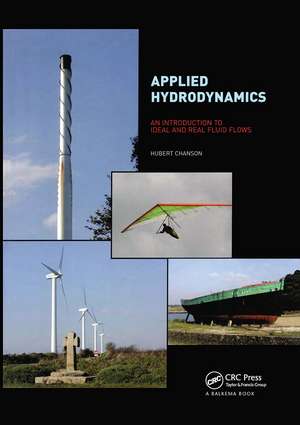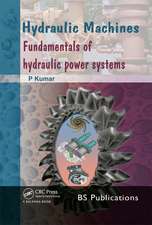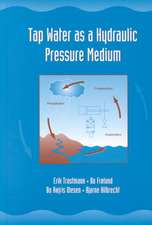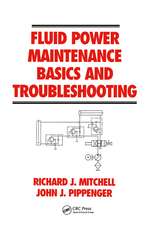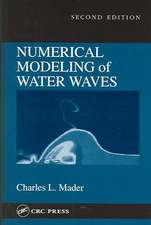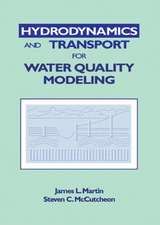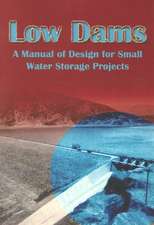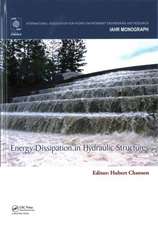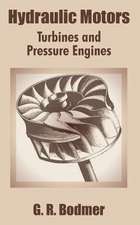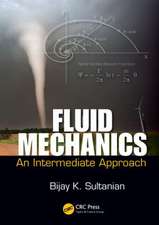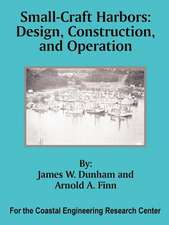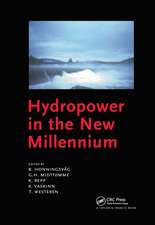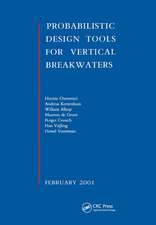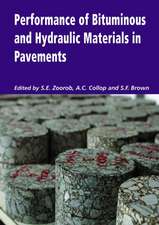Applied Hydrodynamics: An Introduction to Ideal and Real Fluid Flows
Autor Hubert Chansonen Limba Engleză Hardback – 11 mai 2009
This textbook deals with the topic of applied hydrodynamics. The lecture material is grouped into two complementary sections: ideal fluid flow and real fluid flow. The former deals with two- and possibly three-dimensional fluid motions that are not subject to boundary friction effects, while the latter considers the flow regions affected by boundary friction and turbulent shear. The lecture material is designed as an intermediate course in fluid dynamics for senior undergraduate and postgraduate students in Civil, Environmental, Hydraulic and Mechanical Engineering. It is supported by notes, applications, remarks and discussions in each chapter. Moreover a series of appendices is added, while some major homework assignments are developed at the end of the book, before the bibliographic references.
| Toate formatele și edițiile | Preț | Express |
|---|---|---|
| Hardback (2) | 561.57 lei 6-8 săpt. | |
| Routledge – 30 aug 2013 | 561.57 lei 6-8 săpt. | |
| CRC Press – 11 mai 2009 | 1352.55 lei 6-8 săpt. |
Preț: 1352.55 lei
Preț vechi: 1486.32 lei
-9% Nou
Puncte Express: 2029
Preț estimativ în valută:
258.89€ • 281.31$ • 217.61£
258.89€ • 281.31$ • 217.61£
Carte tipărită la comandă
Livrare economică 21 aprilie-05 mai
Preluare comenzi: 021 569.72.76
Specificații
ISBN-13: 9780415492713
ISBN-10: 0415492718
Pagini: 464
Ilustrații: 20 tables, 41 halftones, 41 color halftones and 100 line drawings
Dimensiuni: 174 x 246 x 25 mm
Greutate: 1.09 kg
Ediția:1
Editura: CRC Press
Colecția CRC Press
ISBN-10: 0415492718
Pagini: 464
Ilustrații: 20 tables, 41 halftones, 41 color halftones and 100 line drawings
Dimensiuni: 174 x 246 x 25 mm
Greutate: 1.09 kg
Ediția:1
Editura: CRC Press
Colecția CRC Press
Public țintă
PostgraduateCuprins
Chapter 1 - Introduction
Chapter 2 - Fundamental Equations
Part I - Irrotational Flow Motion of Ideal Fluid
I-1 - Introduction to Ideal Fluid Flows
I-2 - Ideal Fluid Flows and Irrotational Flow Motion
I-3 - Two-Dimensional Flows (1) Basic equations and flow analogies
I-4 - Two-Dimensional Flows (2) Basic flow patterns
I-5 - Complex potential, velocity potential & Joukowski transformation
I-6- Joukowski transformation, theorem of Kutta-Joukowski & lift force on airfoil
I-7 - Theorem of Schwarz-Christoffel, free streamlines & applications
Part II - Real Fluid Flows : Theory and Applications
II-1 Introduction
II-2 Turbulence: an introduction
II-3 Boundary Layer Theory. Application to Laminar Boundary layer Flows
II-4 Turbulent Boundary layers
Chapter 2 - Fundamental Equations
Part I - Irrotational Flow Motion of Ideal Fluid
I-1 - Introduction to Ideal Fluid Flows
I-2 - Ideal Fluid Flows and Irrotational Flow Motion
I-3 - Two-Dimensional Flows (1) Basic equations and flow analogies
I-4 - Two-Dimensional Flows (2) Basic flow patterns
I-5 - Complex potential, velocity potential & Joukowski transformation
I-6- Joukowski transformation, theorem of Kutta-Joukowski & lift force on airfoil
I-7 - Theorem of Schwarz-Christoffel, free streamlines & applications
Part II - Real Fluid Flows : Theory and Applications
II-1 Introduction
II-2 Turbulence: an introduction
II-3 Boundary Layer Theory. Application to Laminar Boundary layer Flows
II-4 Turbulent Boundary layers
Notă biografică
Hubert CHANSON received a degree of 'Ingénieur Hydraulicien' from the Ecole Nationale Supérieure d'Hydraulique et de Mécanique de Grenoble (France) in 1983 and a degree of 'Ingénieur Génie Atomique' from the 'Institut National des Sciences et Techniques Nucléaires' in 1984. He worked for the industry in France as a R&D engineer at the Atomic Energy Commission from 1984 to 1986, and as a computer professional in fluid mechanics for Thomson-CSF between 1989 and 1990. From 1986 to 1988, he studied at the University of Canterbury (New Zealand) as part of a Ph.D. project.
Hubert CHANSON is Professor in Hydraulic Engineering and Applied Fluid Mechanics at the University of Queensland since 1990. His research interests include design of hydraulic structures, experimental investigations of two-phase flows, coastal hydrodynamics, water quality modelling, environmental management and natural resources. In 1999 he was awarded a Doctor of Engineering from the University of Queensland for outstanding research achievements in gas-liquid bubbly flows.
Hubert CHANSON has been active also as consultant for both governmental agencies and private organisations. He is the main author of six books.
Awards received:
- The 13th Arthur Ippen award for outstanding achievements in hydraulic engineering (International Association of Hydraulic Engineering & Research)
- 2004 award for the best practice paper in the Journal of Irrigation and Drainage Engineering (ASCE-EWRI)
Hubert CHANSON is Professor in Hydraulic Engineering and Applied Fluid Mechanics at the University of Queensland since 1990. His research interests include design of hydraulic structures, experimental investigations of two-phase flows, coastal hydrodynamics, water quality modelling, environmental management and natural resources. In 1999 he was awarded a Doctor of Engineering from the University of Queensland for outstanding research achievements in gas-liquid bubbly flows.
Hubert CHANSON has been active also as consultant for both governmental agencies and private organisations. He is the main author of six books.
Awards received:
- The 13th Arthur Ippen award for outstanding achievements in hydraulic engineering (International Association of Hydraulic Engineering & Research)
- 2004 award for the best practice paper in the Journal of Irrigation and Drainage Engineering (ASCE-EWRI)
Recenzii
"..this book merits being read and even studied by a very large spectrum of people who should be able to find it on the shelves of the professional and university libraries that respect themselves." - Jean A. Cunge, Hon. M. IAHR, Société Hydrotechnique de France, Grenoble, France. In: Journal of Hydraulic Research Vol. 51, No. 1 (2013), pp. 109–110
"[T]he combination of theoretical aspects, perfectly developed, with an applied point of view directly related to engineering and research, is an additional asset which is not found in other books covering the same field."
"[T]his book should interest all the students, engineers (beginner or not), researchers and teachers in fluid mechanics whatever their field of predilection. To be strongly recommended." – Dr Frederic Murzyn, ESTACA (France)
"This handbook is of excellent quality and is a great addition to the literature on fluid mechanics."
"The author made a strong pedagogical effort in writing this book. Without any doubt, it will become a standard work in Fluid Dynamics." – Pierre LUBIN, Assistant Professor, Université de Bordeaux
"This should be recommended reading for anyone contemplating numerical calculations or detailed measurements on real engineering geometries, since this training teaches one what to expect."
"[T]his text has a wonderful personal touch, including many illustrations and appendices that spring from the author's love of flows in rivers and seas, of the design of ships and aeroplanes, and of history." – Richard Manasseh, Fluid Dynamics Group
"The book contains some historical remarks and a lot of application and exercises. It handles some aspects in more detail than other books of hydrodynamics and is, thereby, a good completion of the flow mechanics literature." – Prof. B. PLATZER in: Z. Angew Math. Mech., 2011, Vol. 91, No. 5, p. 399.
"Each chapter contains a collection of worked examples, increasing the value of the book for teaching purposes. The coverage of topics within the book is adequate for undergraduate students, but the clarity of presentation of the theory is so well done that it may serve as a good basic reference for Ph.D. students and researchers."
Oscar Castro-Orgaz, Ph.D., Instituto de Agricultura Sostenible, Consejo Superior de Investigaciones Científicas, Córdoba, Spain. In: Journal of Hydraulic Engineering, April 2013, p. 460
"This book merits being read and even studied by a very large spectrum of people who should be able to find it on the shelves of the professional and university libraries that respect themselves." - Jean A. Cunge, Hon. M. IAHR, Société Hydrotechnique de France, Grenoble, France. In: Journal of Hydraulic Research Vol. 51, No. 1 (2013), pp. 109–110
"[T]he combination of theoretical aspects, perfectly developed, with an applied point of view directly related to engineering and research, is an additional asset which is not found in other books covering the same field."
"[T]his book should interest all the students, engineers (beginner or not), researchers and teachers in fluid mechanics whatever their field of predilection. To be strongly recommended." – Dr Frederic Murzyn, ESTACA (France)
"This handbook is of excellent quality and is a great addition to the literature on fluid mechanics."
"The author made a strong pedagogical effort in writing this book. Without any doubt, it will become a standard work in Fluid Dynamics." – Pierre LUBIN, Assistant Professor, Université de Bordeaux
"This should be recommended reading for anyone contemplating numerical calculations or detailed measurements on real engineering geometries, since this training teaches one what to expect."
"[T]his text has a wonderful personal touch, including many illustrations and appendices that spring from the author's love of flows in rivers and seas, of the design of ships and aeroplanes, and of history." – Richard Manasseh, Fluid Dynamics Group
"The book contains some historical remarks and a lot of application and exercises. It handles some aspects in more detail than other books of hydrodynamics and is, thereby, a good completion of the flow mechanics literature." – Prof. B. PLATZER in: Z. Angew Math. Mech., 2011, Vol. 91, No. 5, p. 399.
"[T]he combination of theoretical aspects, perfectly developed, with an applied point of view directly related to engineering and research, is an additional asset which is not found in other books covering the same field."
"[T]his book should interest all the students, engineers (beginner or not), researchers and teachers in fluid mechanics whatever their field of predilection. To be strongly recommended." – Dr Frederic Murzyn, ESTACA (France)
"This handbook is of excellent quality and is a great addition to the literature on fluid mechanics."
"The author made a strong pedagogical effort in writing this book. Without any doubt, it will become a standard work in Fluid Dynamics." – Pierre LUBIN, Assistant Professor, Université de Bordeaux
"This should be recommended reading for anyone contemplating numerical calculations or detailed measurements on real engineering geometries, since this training teaches one what to expect."
"[T]his text has a wonderful personal touch, including many illustrations and appendices that spring from the author's love of flows in rivers and seas, of the design of ships and aeroplanes, and of history." – Richard Manasseh, Fluid Dynamics Group
"The book contains some historical remarks and a lot of application and exercises. It handles some aspects in more detail than other books of hydrodynamics and is, thereby, a good completion of the flow mechanics literature." – Prof. B. PLATZER in: Z. Angew Math. Mech., 2011, Vol. 91, No. 5, p. 399.
"Each chapter contains a collection of worked examples, increasing the value of the book for teaching purposes. The coverage of topics within the book is adequate for undergraduate students, but the clarity of presentation of the theory is so well done that it may serve as a good basic reference for Ph.D. students and researchers."
Oscar Castro-Orgaz, Ph.D., Instituto de Agricultura Sostenible, Consejo Superior de Investigaciones Científicas, Córdoba, Spain. In: Journal of Hydraulic Engineering, April 2013, p. 460
"This book merits being read and even studied by a very large spectrum of people who should be able to find it on the shelves of the professional and university libraries that respect themselves." - Jean A. Cunge, Hon. M. IAHR, Société Hydrotechnique de France, Grenoble, France. In: Journal of Hydraulic Research Vol. 51, No. 1 (2013), pp. 109–110
"[T]he combination of theoretical aspects, perfectly developed, with an applied point of view directly related to engineering and research, is an additional asset which is not found in other books covering the same field."
"[T]his book should interest all the students, engineers (beginner or not), researchers and teachers in fluid mechanics whatever their field of predilection. To be strongly recommended." – Dr Frederic Murzyn, ESTACA (France)
"This handbook is of excellent quality and is a great addition to the literature on fluid mechanics."
"The author made a strong pedagogical effort in writing this book. Without any doubt, it will become a standard work in Fluid Dynamics." – Pierre LUBIN, Assistant Professor, Université de Bordeaux
"This should be recommended reading for anyone contemplating numerical calculations or detailed measurements on real engineering geometries, since this training teaches one what to expect."
"[T]his text has a wonderful personal touch, including many illustrations and appendices that spring from the author's love of flows in rivers and seas, of the design of ships and aeroplanes, and of history." – Richard Manasseh, Fluid Dynamics Group
"The book contains some historical remarks and a lot of application and exercises. It handles some aspects in more detail than other books of hydrodynamics and is, thereby, a good completion of the flow mechanics literature." – Prof. B. PLATZER in: Z. Angew Math. Mech., 2011, Vol. 91, No. 5, p. 399.
Descriere
This textbook covers applied hydrodynamics grouped into two complementary sections: ideal fluid flow and real fluid flow. The former explores two- and possibly three-dimensional fluid motions that are not subject to boundary friction effects, while the latter considers the flow regions affected by boundary friction and turbulent shear. The lecture material is supported by notes, applications, remarks and discussions in each chapter. Appendices, major homework assignments, and bibliographic references can be found at the end of the book.
